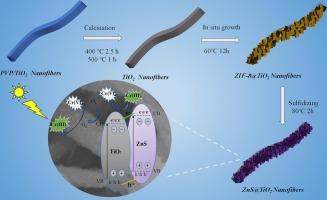ZIF-8衍生ZnS修饰的电纺丝TiO2纳米纤维高效光催化还原Cr(VI)
IF 6.9
2区 材料科学
Q2 CHEMISTRY, PHYSICAL
引用次数: 0
摘要
设计和构建不同的异质结结构已成为提高半导体光催化性能的有效策略。本研究通过静电纺丝技术与原位溶剂热法相结合,成功制备了ZIF-8/TiO2复合纳米纤维,并对ZIF-8进行硫化,形成ZnS/TiO2纳米纤维异质结构。综合表征证实,TiO2纳米纤维表面的ZIF-8完全转化为ZnS,与TiO2建立了牢固而紧密的界面。所得的ZnS/TiO2异质结对Cr(VI)表现出了显著的光催化还原活性,在可见光照射下,在20 min内达到100%的去除率。ZnS@TiO2纳米纤维的光催化反应速率常数分别比原始ZnS和TiO2纳米纤维高约10倍和319.5倍。这种增强的光催化性能归因于异质结的形成,它有效地缩小了复合材料的带隙,优化了光产生的电荷转移途径,并显著改善了电子-空穴对的分离。此外,机理研究发现光生电子(e−)和超氧自由基(O2−)是参与光催化还原过程的主要活性物质。这项工作为开发高性能二氧化钛光催化系统提供了基本的理解和实用的方法,突出了它们在先进水净化技术方面的潜力。本文章由计算机程序翻译,如有差异,请以英文原文为准。


ZIF-8 derived ZnS decorated electrospun TiO2 nanofibers for highly efficient photocatalytic reduction of Cr(VI)
The design and construction of diverse heterojunction structures have emerged as an effective strategy for enhancing the photocatalytic performance of semiconductors. In this study, ZIF-8/TiO2 composite nanofibers were successfully fabricated by combining electrospinning technology with a facile in-situ solvothermal method, followed by ZIF-8 sulfurization to form ZnS/TiO2 nanofiber heterostructures. Comprehensive characterization confirmed that ZIF-8 on the surface of TiO2 nanofibers was completely converted into ZnS, establishing a robust and intimate interface with TiO2. The resulting ZnS/TiO2 heterostructures exhibited remarkable photocatalytic reduction activity for Cr(VI), achieving 100% removal efficiency within 20 min under visible light irradiation. The photocatalytic reaction rate constant of the ZnS@TiO2 was approximately 10 and 319.5 times higher than those of ZnS and TiO2 nanofibers, respectively. This enhanced photocatalytic performance is attributed to the formation of the heterojunction, which effectively narrows the bandgap of the composite, optimizes photogenerated charge transfer pathways and significantly improves electron-hole pairs separation. Furthermore, mechanistic studies identified photogenerated electrons (e−) and superoxide radicals (![]() O2−) as the dominant active species involved in the photocatalytic reduction process. This work provides both fundamental understanding and practical methodology for developing high-performance TiO2-based photocatalytic systems, highlighting their potential for advanced water purification technologies.
O2−) as the dominant active species involved in the photocatalytic reduction process. This work provides both fundamental understanding and practical methodology for developing high-performance TiO2-based photocatalytic systems, highlighting their potential for advanced water purification technologies.
求助全文
通过发布文献求助,成功后即可免费获取论文全文。
去求助
来源期刊

Applied Surface Science
工程技术-材料科学:膜
CiteScore
12.50
自引率
7.50%
发文量
3393
审稿时长
67 days
期刊介绍:
Applied Surface Science covers topics contributing to a better understanding of surfaces, interfaces, nanostructures and their applications. The journal is concerned with scientific research on the atomic and molecular level of material properties determined with specific surface analytical techniques and/or computational methods, as well as the processing of such structures.
 求助内容:
求助内容: 应助结果提醒方式:
应助结果提醒方式:


